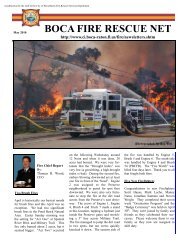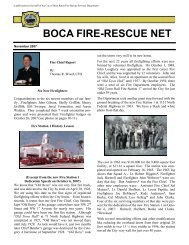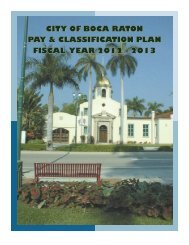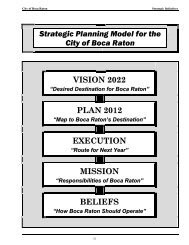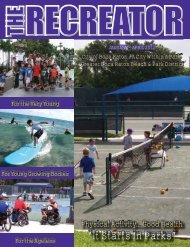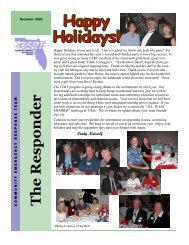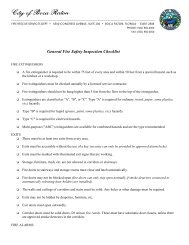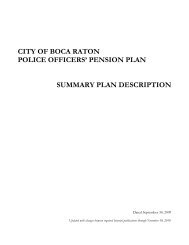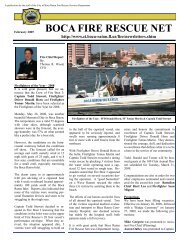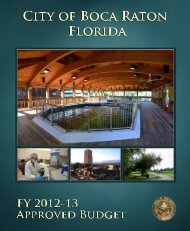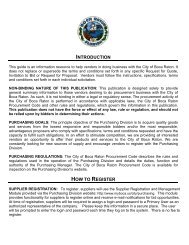Master Plan Development - City of Boca Raton
Master Plan Development - City of Boca Raton
Master Plan Development - City of Boca Raton
You also want an ePaper? Increase the reach of your titles
YUMPU automatically turns print PDFs into web optimized ePapers that Google loves.
<strong>City</strong> <strong>of</strong> <strong>Boca</strong> <strong>Raton</strong> Regulatory Information SummaryMS4 NPDES Permit ProgramAs described in Rule 62-303, F.A.C., water quality sample values in exceedence <strong>of</strong> the applicable WQStandards are the primary tool for the assessment <strong>of</strong> water body impairments.Values exceeding the WQ Standard for pH are those less than 6.5 or greater than 8.5. Exceedence <strong>of</strong> theStandard for dissolved oxygen occurs at all values below 5.0 mg/L. Turbidity exceedences occur at allvalues above 29.0 nephelometric turbidity units (“NTU”). Background turbidity is conservativelyassumed to be zero. The WQ Standard exceedence limits for fecal coliform and arsenic are 800 cfu/100mL and 0.05 mg/L, respectively. This WQ Standard for arsenic applies only to Class I and Class IIIfreshwater systems. There is no WQ Standard for arsenic in marine systems.For Class I and Class III freshwater, exceedence limits for heavy metals (cadmium, copper, lead, andzinc) are based on a logarithmic function <strong>of</strong> the total hardness. In cases where a total hardness was notmeasured or was below the limits <strong>of</strong> detection, an exceedence limit was not calculated. For marinewaters, the limits for heavy metals are constant and do not depend on the total hardness. Cadmium,copper, lead, and zinc exceed the surface WQ Standards at values above 0.0093 mg/L, 0.0029 mg/L,0.0056 mg/L, and 0.086 mg/L respectively in marine waters.Exceedence limits for chlorophyll-a (corrected for pheophytin) are determined by the annual mean <strong>of</strong> thesamples taken at a given site, per the Impaired Waters Rule. In freshwater systems, the required annualmean is exceeded if the average <strong>of</strong> all sample values is greater than 20 mg/m 3 . In marine systems,exceedences occur when the average value <strong>of</strong> all sampling events is greater than 11.0 mg/m 3 . In lieu <strong>of</strong>numeric limits for nutrients, chlorophyll-a measurements are used as an indicator <strong>of</strong> elevated nitrogen anphosphorous levels.Copper limits are related to total hardness in freshwater systems but are constant in marine systems.Limits for copper in freshwater systems typically vary within the range <strong>of</strong> 0.015 to 0.025 mg/L, an order<strong>of</strong> magnitude greater than that allowed by the 0.0029 mg/L limit applied to marine systems. Copperlevels which may remain relatively constant from west to east in the freshwater watersheds will result in agreater occurrence <strong>of</strong> exceedences in the marine watershed due to the freshwater inflows to the marinewatersheds and discrepancy in the value <strong>of</strong> the limits on which the determination <strong>of</strong> impairment is based.Review <strong>of</strong> the water quality monitoring results from previous years has revealed that the highestoccurrence <strong>of</strong> exceedences appears for the following five parameters:Dissolved Oxygen (w/ temperature)Total NitrogenTotal PhosphorusChlorophyll-a (corrected for pheophytin)CopperL:\boca\bocaswmp\A6016.02\Final Task 2 Report - 1-07-08\r01acjh.docPage 16MOCK•ROOS




